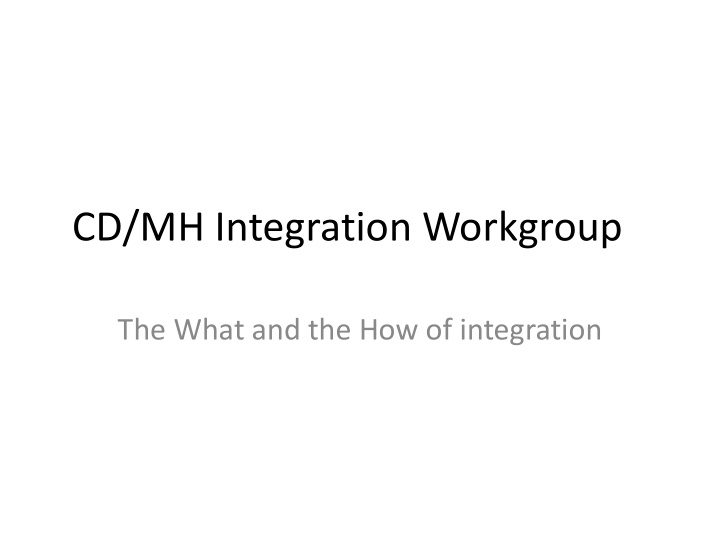



CD/MH Integration Workgroup The What and the How of integration
CD Integration Workgroup RECOMMENDATIONS TO THE TASK FORCE July 18, 2014 Each Behavioral Health Organization should provide rapid access to the following billable services along a continuum of care for chemically dependent clients: Each BHO will need to arrange for access to the full range of services but does not necessarily need to have all types of facilities within their geographic coverage area. This is similar to the network requirement for RSNs – the need to arrange for all medically necessary services does not mean all types of services will need to exist in the geographic coverage area. This is an important distinction for the actuary process because it means that every BHO will need to have included in its rates the types of services (i.e. acute detox and sub-acute detox) , even if some of those services are not located within their geographic area. Outreach/engagement : proactively seeking out individuals in need of CD treatment, encouraging them to seek treatment, and helping to connect them to care (e.g. at needle exchanges, homeless encampments, etc.) Pre-treatment/interim services : help and support for individuals who are waiting to get into treatment (e.g. waiting for detox, waiting between detox and residential). This could include having a case manager call every day to check in or having a client come in once or twice per week until they can get into treatment Withdrawal management : (formerly known as “detox”) inpatient, outpatient/ambulatory, acute, sub-acute, and medication assisted Outpatient treatment : abstinence only, medication assisted, and co-occurring Intensive outpatient treatment (IOP) : abstinence only, medication assisted, and co-occurring Residential treatment : short and long term, including care for specialty populations such as pregnant and parenting women (PPW) and ethnic minority communities, medication assisted, and co-occurring Integrated crisis response services : integrated mental health/chemical dependency outreach and detention services for individuals in crisis Case management/care transitions (care coordinators/navigators) : for patients in all levels of care, including discharge planning from hospitals and jails, in order to safely transition and not “drop off” in between levels or types of care Peer services : peer support specialists are central to the recovery model and should be utilized along the entire continuum of care Recovery supports : including support with access to housing (ATR likely going away), transportation, job training (supported employment), and childcare It is imperative that this continuum of services is not condensed or diminished as a result of the transition to BHOs. It is because of the broad range of services (e.g. medication assisted options, programs for individuals involved in the criminal justice system, pregnant and parenting women programs) that our clients have the positive outcomes that they do today.
WAC’S/Policy/Federal Regulations 1. 42 CFR part 2 vs HIPAA • Barrier: 42 CFR part 2 federal guidelines on confidentiality inhibits the ability to share information in an integrated system that HIPAA allows for. In order to truly integrate, CD has to be able to coordinate care that is in the best interest of the patient. • Solution: We would like Washington state to continue to work along side other states to get the Federal government to allow for integrated confidentiality sharing that meets HIPAA guidelines. Additionally the state may be able to provide a waiver based on 42 CFR interpretation.
WAC’s/Policy/Federal Regulations 2. Integrated Data/Information systems. Barrier: No current structure in place to allow for • integrated data collection. Solution: Work with both CD and MH to develop an • integrated system that meets the needs of both. It should have representative from providers and counties to IT and those in between to ensure that we meet all needs.
WAC’s/Policy/Federal Regulations 3. Integrated Assessment Tool Barrier: There is no standard assessment tool for both • MH and CD. Both incorporate Biopsychosocial needs in their assessments. CD is required to use an ASAM assessment while MH is required to access to care standards to help determine placement. Solution: Create a standard assessment tool that • would meet the needs of both CD and MH, individually and together, while providing a unified patient placement.
Funding 1. Properly fund T-19 and State-only funds for Medicaid and Non-Medicaid. Barrier: Currently the T-19 reimbursement rate is • insufficient to cover the cost of providing treatment. We are not able to be competitive in hiring and retaining staff. We need to ensure that we are able to cover the continuum of care. – True Parody. Solution: Reimbursement that is truly representative • of the cost of business. Create true parody within MH and CD.
Funding 2. 16 bed non-IMD/IMD requirement. • Barrier: There is a new IMD waiver granted, MH can bill Medicaid for acute services in IMD facilities but CD cannot. This is diminishing the capacity for CD facilities. • Solution: Washington state to continue to work with other states around the nation to eliminate this archaic rule that was much less of an issue prior to Medicaid expansion.
Workforce Recommendations. 1. CD/MH/PC Integration Training. Barrier: There is no infrastructure for CD/MH/PC • integration training. Lack of funding to get workforce integrated, especially your smaller agencies. Solution: Create an infrastructure for CD/MH/PC • integration training. Help with funding issues to create an integrated workforce.
Workforce Recommendations 2. Lack of Capacity – MH and CD staff. Barrier: Lack of Coursework at colleges, and decrease • in interest due to wages. Retirement of current workforce with no new recruits for replacement. Solution: Reciprocity with other states addressed, • made simple and more open. On the Job training needs to be recognized to help with integration. MH and CD/CDPT credentialing needs to be integrated as well.
Recommend
More recommend